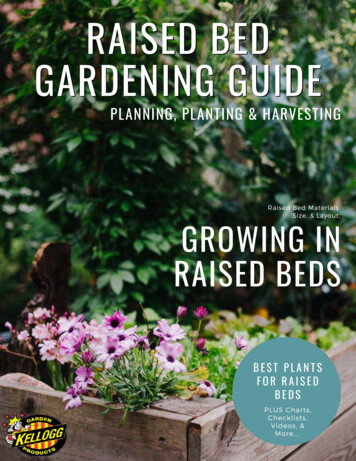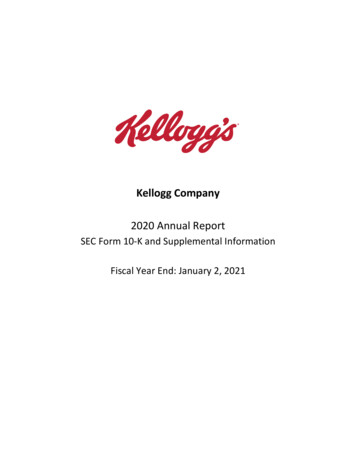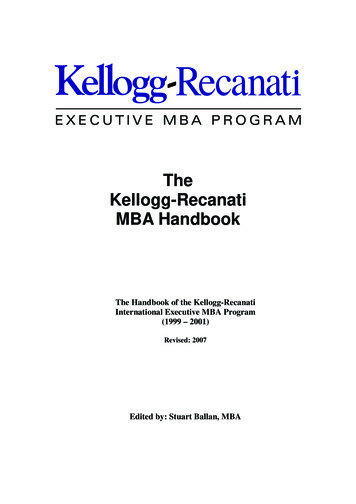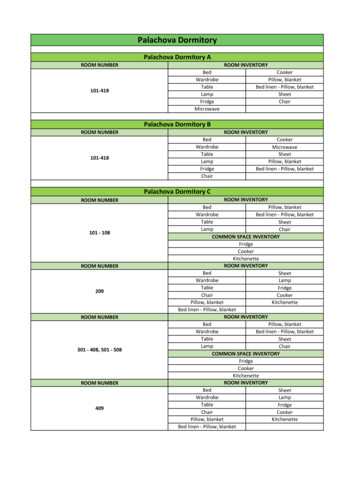
Transcription
RAISED BEDGARDENING GUIDEPLANNING, PLANTING & HARVESTINGTHE MAGAZINE FOR BIBLIOPHILESFEBRUARY 2016Raised Bed Materials,Size, & Layout.GROWING INRAISED BEDSBEST PLANTSFOR RAISEDBEDSPLUS Charts,Checklists,Videos, &More.
FALL GARDENINGCONTENT3Raised Bed Gardening, Benefits, &Planning6Finding Your Planting Zone8Raised Bed Garden Materials11Raised Bed Garden Designs & Layouts17Raised Bed Garden SoilSelecting, layering, & amending soil.20Growing Fruits & Vegetables In ARaised Bed GardenPlanting & growing fruits & vegetables inraised beds.28Companion Planting30Extending Your Season32Dealing with Common Pests33Printable Garden Worksheets36Additional Resources & eBooks37About Kellogg Garden Organicswww.kellogggarden.com2/38
Organic Gardening:Raised Bed GardeningRaised bed gardening is the art of cultivating plants in structures above theground’s surface. The benefits of raised bed gardening are innumerable. Soilthat is raised off the ground can be controlled for quality, creating a warm,nutrient-rich, well-draining growing environment for optimal root developmentand plant growth.Raised bed structures allow for better soil, can maximize your growing space,lessen the need for bending, weeding, and can even ward off pests. Raised bedscan be designed in so many ways and be constructed from wood, metal, stone,and brick; but what to plant in a raised garden bed?The exciting answer is that you can grow just about anything in a raised gardenbed as long as growing conditions such as sunlight, spacing, and temperatureare on target for your plants.www.kellogggarden.com3/38
Organic Gardening:Raised Bed Gardening BenefitsRaised garden beds are excellent long-term investments that provide gardenerswith a multitude of benefits. They give the gardeners some great benefits,lessening the need for bending, weeding, and they even provide the ideal warmand fertile environment for root systems to thrive for better growth.Space Efficiency:Raised beds are fantastic forgardeners with limited garden spaceas they can easily be built on top ofundesirable growing areas.Enhanced Soil:You can control the soil quality inyour raised garden beds as opposedto working with your ground soilwhich can be more difficult to amend.Less Work:Gardening in raised garden beds,especially those elevated off of theground, makes for less arduous worksuch as bending, weeding, watering,and harvesting.Weed Control:If you put down cardboard andnewspaper, then your soil, and top itwith cardboard and mulch, you cansignificantly cut down on those peskyweeds in your raised bedswww.kellogggarden.com4/38
Organic Gardening:Raised Bed Garden PlanningThere are a few key points to keep in mind when embarking on the raisedgarden bed journey. These pointers will help you on your way to growingstrong and healthy plants that produce large harvests that are safe to consume.Select an area of the yard that has full sun conditions.Ensure that your design allows you access to your garden beds forharvesting, weeding, and pruning. Raised beds should have at least 2 feet ofwalking space between them and be no wider than 4 feet across so you caneasily reach the middle of the beds.Go vertical! Add trellises and obelisks, and connect beds with archedclimbing structures.Use landscaper’s paint to ‘sketch’ out your raised garden beds’ layoutbefore building them.Use upcycled materials and reclaimed wood to build your beds. Alwayscheck the source of the wood and make sure it hasn’t been chemicallytreated as chemicals can leach into your soil, contaminating your crops.Avoid pressure-treated wood.Make sure your raised beds are nice and deep. Extra soil depth equals freelyextending roots as your plants grow and more moisture retention. Raisedgarden beds should be a minimum of 6 – 12 inches deep.Gardens grow best when there are plenty of pollinators around, so plantwith the intention to draw beneficial insects to the garden.www.kellogggarden.com5/38
Organic Gardening:Finding Your Planting ZoneSome of your vegetable garden’s success will be directly related to what youplant in your garden and when you plant it. It is vital to know what grows bestin your USDA grow zone and what will not thrive where you live.The United States Department of Agriculture (USDA) Plant Hardiness ZoneMap provides an informative view of average temperature trends across TheUnited States and Canada. Zone Hardiness maps are based on the averageyearly extremes for minimum temperatures in a given area.CLICK HERE TO FIND YOUR ZONEThe USDA Zone Hardiness Map is divided up into 13 planting zones. They aresectioned off by a 10-degree Fahrenheit differential for the average annualminimum temperatures. The larger the number is, the warmer the temperatureis in the corresponding garden zone. For added clarity, zones are broken downinto subsets of a and b, which represents a 5-degree differential in which a iscolder than b is.www.kellogggarden.com6/38
Organic Gardening:Plan For Your Planting ZoneWhether you're growing vegetables, herbs, or flowers it's crucial to plan foryour growing zone. Our Planting Charts for Zones 1-10 provide information onplanning, planting, and harvesting specific to your egetable PlantingChart for Zones 1-10Herb Planting Chart forZones 1-10Flower Planting Chart forZones 1-10
Organic Gardening:Raised Bed Garden MaterialsRaised beds can be made from a variety of materials that can be sourced inmany ways. You can use just about anything to build a raised bed, but it isparamount that you do not use chemically treated materials for growingedibles. Rocks, metal, brick, untreated pallets, wood, cinderblock, mortaredstone, and more all make great raised bed garden materials.Wood:Inexpensive and a great project forthe garden DIYer. Wood is also agreat option if you want a moretraditional look. Use rot-resistantwoods like cedar, redwood, or yewand avoid pressure-treated woods.Cinderblock:Another inexpensive choice,cinderblock is easy to locate andstack. You can mortar them or simplystack them, using a brick pattern forstability. Cinderblocks add a cool“industrial chic” look to your garden.Steel:While not the most common nor theleast expensive choice, steel isbecoming increasingly popular forraised bed construction. They add aunique look to the garden and canoftentimes be built at home.www.kellogggarden.com8/38
Raised Bed Garden MaterialsUpcycled Raised BedsWooden Raised BedsUse untreated scrap wood or palletsUse raw lumber or untreated woodKeep painted areas on the outsideUse raw linseed oil to protectCheck for nails or other debrisCan be DIY'ed or purchasedMay need to be replaced soonerMay need to be replaced soonerCost effective & sustainableCost varies based on wood typeMetal Raised BedsBrick/Stone Raised BedsCan be DIY'ed or purchasedSemi-permanent structureGalvanized metal best for DIYCan be rustic & natural lookingCan be pricier than other materialsCan be pricier than other materialsVery long lasting & uniqueVery long lasting & uniqueAvailable in a variety of metalsStack with or without mortar
Organic Gardening:Raised Bed Garden DesignsGardens are an ever-evolving work in progress. It can be fun to try newgardening techniques and carve out new garden spaces, and an excellent placeto start is with some raised garden beds.There are no set parameters for raised bed gardens and no limits to their size orshape, but planning out a thoughtfully designed raised bed garden can benefitgardeners in many ways.Pallet Raised Beds:Use untreated wood pallets to build your garden beds. Most pallets aretreated in some way for preservation and pest control. Before using anypallets for your edible garden, take a close look to see how the pallet wastreated. Look for pallets that have been heat treated.Square Foot Garden Grids:Designs that focus on segmentingthe growing space into one-squarefoot sections is a fantastictechnique. The aim is to plantintensively for maximumproductivity.www.kellogggarden.comHoop House Raised Bed:Expand your growing season andprotect your plants by incorporatinga protective hoop-house into yourraised bed structure. A hoop housewill help protect plants from frost,heat, and garden pests and critters.10/38
Organic Gardening:Raised Bed Garden DesignsMetal Troughs:If you don’t have the time or knowhow to build your own raised beds,invest in some metal animal troughsand turn them into raised gardenbeds. Fill them with raised bed soil,add some drainage holes, and enjoythe industrial style.Trellised Garden Beds:Incorporate vertical gardening intoyour raised garden beds by addingarches or trellises to your plantingspaces. Consider using cattle panelto create an archway that connectstwo beds and grow climbing veggiescreating a magical, secret garden.U- Shaped Raised Beds:Placing your raised beds in a u-shape is excellent for accessibility and anefficient use of growing space. It creates a center pathway and providesplenty of growing space.www.kellogggarden.com11/38
Organic Gardening:Raised Bed Garden LayoutRaised Bed Spacing & HeightIDEAL:Space 2-4 ft. apart, leaving room to walk & work4 ft. wide beds, allow easy access to the middle4 FT. WIDE2 FT. BETWEEN6 IN.DEEPFor more comfort, add a thick edge to sit or lean onBeds should be a minimum of 6 inches deepPRO DESIGN TIPS:Mulch between beds to deter pests & weedsConsider proximity to water sourceConsider sun path & duration year-roundConsider plant height and spreadAVOID IF POSSIBLE:Beds that don't have enough space to walk betweenBeds spaced so that you cannot reach the middleBeds that are difficult to work in for long periodsBeds that are too shallow to grow a variety of plantsADDITIONAL CONSIDERATIONS:Choose bed designs that are functional & affordableChoose bed materials that will lastCalculate Soil Cost: L x W x H Cubic Ft.Think Long Term: It may be difficult to move beds
Organic Gardening:Raised Bed Garden LayoutRows of Raised BedsEfficient design allows for varying bed sizesDifferent depths allow for more plant varietyGreat DIY project, use any materialAdd trellises, square ft. garden, or row coversBeds are easy to access & work inLayout can be adjusted to fit any spaceU Shaped Raised BedCenter pathway increases accessibilityCan be your preferred height or widthGreat DIY project, but a bit more advancedA design not suited for small spacesGreat for companion plantingUnique raised bed layoutTiered Raised Bed GardenVaried soil depths more plant varietyTop planting areas have deeper soilLower areas have more shallow soilIntegrate your garden into your landscapeCan accommodate large and small plantsUnqiue layout for large of small gardenswww.kellogggarden.com13/38
Garden PlanningChecklistAdditional Notes:
Organic Gardening:Raised Bed Garden VideosTake a deeper dive into raised bed gardening by visiting the Kellogg GardenYoutube channel. Learn how to build your own raised beds and trellises,planting tips and techniques for raised gardens, and how to start wormcomposting inside your beds for top-notch soil.5 RAISED GARDEN BEDMISTAKES TO AVOIDHOW TO BUILD A "NO NAILS"4X4 RAISED BEDDO RAISED BEDS NEED ABOTTOM?WORM COMPOSTING IN RAISEDBEDSVIEW MORE VIDEOSJoin us onwww.kellogggarden.com15/38
Organic Gardening:Raised Bed Garden SoilSoil composition is a key element to planting and growing vegetables in raisedbeds. Filling your raised bed vegetable garden is an opportunity to obtainsuperior soil and to tweak the quality using beneficial soil amendments.As plants consume nutrients, the soil needs replenishing by adding organicmatter. As a gardener, you are in complete control of the soil that your cropswill be growing in. Luckily, there are products out there to help you ensure thatyou get your soil just right.Raised Bed Garden SoilConsider using Raised Bed Soil to fill up your garden beds. Sold by the bag,raised bed garden soil is specifically formulated for raised beds and is the idealsoil recipe for raised bed gardening. Raised Bed Soil is formulated to be used asa stand-alone soil mix in a raised bed that sits on the soil or is wholly enclosedin a container.It provides the picture-perfect opportunity to establish the most favorablegrowing environment for your plants. Organic Raised Bed Soil is well-drainingand takes the guesswork out of determining the soil quality because it isalready pH balanced to be between 5.8 and 7.5, which is optimal for growingvegetables.www.kellogggarden.com16/38
Organic Gardening:Raised Bed Soil AmendmentsEven if you have top-notch raised bed soil in your vegetable garden beds, it isessential to amend your soil with organic matter and compost to replace thenutrients that are being readily used by the plants that grow there.Top dress the soil in your garden beds twice per year by adding:Rotted leavesWell-decomposed compostWorm castingsFeather mealDecomposed poultry manureGrass clippingsMulching A Raised Vegetable GardenThe rich, lightweight soil in a raised vegetable garden bed is ideal foroptimizing root growth but the soil itself can be prone to moisturedepletion. Consider adding a couple of inches of mulch to the top of thesoil and around plants to help to retain moisture and regulate temperaturesin the garden bed.A protective layer of mulch will allow moisture to seep into the soil to theplants’ roots without being evaporated by the sun’s intense rays. Mulchalso helps counteract and prevent soil erosion and soil compaction.www.kellogggarden.com17/38
Organic Gardening:Layering Organic MaterialsFilling raised beds with high-quality soil can be pretty expensive — but as agardener, you know that everything starts with healthy soil, and you don’t wantto cheap out, right? Fortunately, when you have raised beds that are 18” – 24”deep, you can layer the material in your raised beds, conserving the top 12” foryour more expensive, high-quality soil.Check out this video to learnmore about layering soil andother organic materials in araised bed garden and watchBrijette from San Diego SeedCompany put this practiceinto action.Click Here to WatchAll of your materials need to be organic. Over time, the layers will decompose,but remember how deep your layers are when digging and turning the soil so asnot to disrupt your raw materials. Below is an example of how to layer:Bottom - Layer 1:Wood materialsNewspaperCardboardWell-decomposed manureMiddle - Layer 2:LeavesGrass clippingsWell-decomposed compostWorm castingsTop - Layer 3:High-quality, organic soilwww.kellogggarden.comMulch18/38
Organic Gardening:Raised Bed Garden VeggiesBrassicasDAYS TO MATURITY35 - 150Brassicas make great first-round early crops in a raised bed environment. Theyhave a tendency to bolt in hot temperatures and love the regulated soiltemperatures that raised beds to provide. Soil is kept warmer, which can beseason extending for both early and later season crops. They can also becovered easily in raised beds, making it easy to obtain a fall and winter harvest.BroccoliCauliflowerArugulaBeets & RadishesCabbageKaleBrussel SproutsDAYS TO MATURITY30 - 60Beet plants and radishes are lovely root vegetables that thrive in the loose soilof raised beds, and they grow particularly well when not in competition withweeds or impeded by rocky soil. Due to their quick maturation times, theymake ideal succession-planted crops.CarrotsDAYS TO MATURITY50 - 80Carrots are phenomenal candidates for raised bed growing. Raised beds provideloose, well-draining soil where carrots can grow unimpeded by rocky ground.Because they produce fruit underneath the soil and their habit is relatively low,they can be tucked in easily under taller plantings’ protection.www.kellogggarden.com19/38
Organic Gardening:Raised Bed Garden VeggiesCeleryDAYS TO MATURITY130 - 140Celery is just begging to settle its roots in a raised bed. It can be a finicky plantthat requires plenty of moisture, cool temperatures, nutrient-rich soil, and along growing season. Raised beds can keep aphids and root nematodes at bayas well.CucumbersDAYS TO MATURITY50 - 70Cucumbers will flourish in raised beds. Allow them to cascade over the sides ofraised beds to maximize space for these prolific fruiting plants. Allow yourcucumbers to grow vertically by adding a trellis to your beds for an even moreprolific harvest.Kale & Swiss ChardDAYS TO MATURITY50 - 75Kale and Swiss Chard are fantastic late-season crops in raised beds. They keepthe soil from compacting, thrive in cooler temperatures, and can be coveredwith hoop houses or cold frames to extend their growing season, supplying youwith a fall and winter harvest.www.kellogggarden.com20/38
Organic Gardening:Raised Bed Garden VeggiesLegumesDAYS TO MATURITY45 - 75Legumes fix nitrogen back into the soil as they grow, so they do double duty inthe raised garden bed. They boost the nutrient content of the soil whileproducing plentiful harvests. They often can be found in freestanding andclimbing varieties, both of which can be cultivated in raised beds.ChickpeasBush & Pole BeansLettuce, Spinach & Mixed GreensPeasLentilsDAYS TO MATURITY30 - 60Lettuce, spinach, and mixed salad greens thrive in the warm soil temperaturesand well-draining soil of raised beds. As a gardener, you will love that you canextend your growing season by planting them earlier and successively all theway through winter with the proper protections in place.Peppers & EggplantDAYS TO MATURITY60 - 120When we think about what to plant in a raised garden bed, eggplant and funpeppers often come to mind for a good reason. They thrive in the warm soils ofraised beds and are heavy feeders of nutrients. Raised beds make it easier forgardeners to keep up with these bountiful producers’ nutrient and wateringrequirements.www.kellogggarden.com21/46
Organic Gardening:Raised Bed Garden VeggiesPotatoesDAYS TO MATURITY60 - 90Potatoes thrive in a raised garden bed. Growing in soil that is well-drainingprevents rot, and the loose soil allows tubers to form fully, unimpeded by densesoil and rocks.Squash & ZucchiniDAYS TO MATURITY50 -80Large vegetables like squash and zucchini can most definitely be planted inraised beds. Bush varieties have an open habit and make excellent additions toraised beds. You can also allow quick-growing, vining plants to flow out overthe edges of raised beds or add trellises for them to climb on.TomatoesDAYS TO MATURITY50 - 80Tomato plants thrive on stretching their roots deep into loose soil, eager tofeed heavily. They love full sun conditions and make fantastic additions toraised garden beds. Since tomato plants can grow quite tall, plant them in therear of a raised garden bed. Add tomato cages for support.www.kellogggarden.com22/38
Organic Gardening:Tips on Growing Large PlantsLarge fruits and vegetables are often overlooked when it comes to raisedgarden beds because gardeners assume that they take up too much space.Large fruits and vegetables are actually excellent options for raised beds andtheir space consumption can be managed by creating a vertical garden as wellas overflow techniques.Allow vining varieties to spill over the edgeof the raised bed, creating a cascade ofvining fruits and vegetables. Plant viningvarieties on the edges of raised beds andguide any straying vines over the side.If you grow vining crops on a trellis, youcan bolster them by adding mesh to thetrellis to support developing fruit andprevent them from breaking off of the vinebefore they are ready.Consider planting these large fruits and vegetables in your raised bed garden:MuskmelonWatermelonCantaloupeHoneydew MelonPumpkinsGourdswww.kellogggarden.comCorn (must be grown in blocks)OkraZucchini & SquashRhubarbKaleSwiss Chard23/38
Organic Gardening:Raised Bed Garden FruitsMelonsDAYS TO MATURITY70 - 100Large fruiting plants like melons thrive in raised beds because their warm, pHbalanced soil that is rich in nutrients and provides adequate drainage is the idealgrowing environment for juicy melons of all varieties. These vining plants canbe allowed to spill over the sides of raised beds or be trained to climb trellisesor other climbing structures to maximize space.BlueberriesDAYS TO MATURITY-Blueberries like to be planted as early in the spring as possible, but only afterthe last frost. They love acidic soil with a pH between 4.0 and 5.0. Opt for aswarf blueberry plant as large ones can take up a significant amount of space inyour raised bed.StrawberriesDAYS TO MATURITY-Strawberry plants produce particularly well where the soil is warm, and thesunlight is plentiful. Raised beds offer these optimal conditions, and they alsohelp protect strawberry plants from menacing slugs that seek to feed on theirsucculent fruits.www.kellogggarden.com24/38
Organic Gardening:Gardening VideosTake a deeper dive into raised bed gardening by visiting the Kellogg GardenYoutube channel. Learn how to start seeds like a pro and build and designyour own garden trellises.11 GARDEN TRELLIS IDEASHOW TO BUILD A CUCUMBERTRELLIS FOR RAISED BEDSSEED STARTING FOR NEWGARDENERS5 SEED STARTING HACKSVIEW MORE VIDEOSJoin us onwww.kellogggarden.com25/38
VEGGIES, FRUITS,FLOWERS, & HERBSVEGGIESFRUITSCultivate a lush raised bed vegetable gardenusing these popular veggies.Fruits make tasty additions to a raised gardenbed, try these growing these fruits & NTKALELEAFY GREENSLEGUMESPEPPERSPOTATOESSQUASH & RAWBERRIESWATERMELONFLOWERSHERBSFlowers add beauty, attract pollinators, deterpests, & enhance the flavor of a raised garden.Herbs make great additions to any raised bedand like flowers, can enhance your veggies.BLACK-EYED MINTOREGANOPARSLEYTHYMESAGESORREL
Organic Gardening:Raised Bed Companion PlantingWhen deciding on what to plant in a raised garden bed pairing plants togetherin the same bed can be mutually beneficial, boost plant growth and production,draw beneficial pollinators, enhance flavor, and even ward off destructive pests.Some plants are tall and can provide much-needed shade and protection toplants that thrive in partial sun conditions. Other plants draw beneficialpollinators to the garden or even act as pest deterrents when planted inproximity to individual plants.Here are some suggested pairings for a raised garden bed:Basil repels mosquitos and flies and can improve the flavor of tomatoes.Thyme is a scented herb that repels certain varieties of parasitic wormsthat seek to destroy strawberry plants.Plant lavender near fruit to attract beneficial pollinators.Nasturtiums, marigolds, sunflowers, and zinnias can be helpful atrepelling harmful insectsCosmos attract many helpful insects that feed on problem insects whoeat vegetables.Marigolds keep damaging insects at bay both above and below theground.www.kellogggarden.com27/38
Organic Gardening:Fun Plant PairingsWhen trying to determine what to plant in a raised garden bed, have a little funwith your plant pairings. Encourage the farm-to-table concept and makeharvest time even more exciting by planting edibles in groups according to whatyou like to eat.Create a Pizza GardenMake gardening a family affair and create a pizza garden in an area of yourraised bed or dedicate a whole raised bed to the theme of pizza. Not onlywill it be convenient to have all of your homegrown pizza ingredients inone place, but planting herbs such as basil, oregano, parsley, and thymenear your tomato plants can actually boost their liParsleyThymeBasilPlant a Salad BowlIf salads are a staple in your diet, plant your own mix of greens and saladaccouterments together in the same raised garden bed. Consider some ofthese tried and true salad bowl favorites when planting:SpinachLettuce varietiesGarbanzo asilCherry tomatoesRed onions28/38
Organic Gardening:Extending Your SeasonRaised beds offer a number of advantages when trying to extend your gardenseason — root veggies have more room to develop, the soil is not compacted,and weeds are less of an issue.Here are some additional ways to protect your crops and extend your season :Start Seeds Indoors:This can be done year-round, ofcourse, but starting your own seedsindoors not only saves money but itallows you to hit the ground runningwhen it’s planting time.Weed:If plants have to compete with weedgrowth, their own growth can suffer.So stay on top of those weeds to giveyour seedlings and transplants a goodstart.Protect From Frost:Use a variety of methods such assheets, freeze cloth, row covers, andcold frames to protect your plantsfrom frost. Know your hardinesszones and water lightly the nightbefore an expected frost or freeze tocreate insulation.Use Row Covers:Row covers can simultaneouslyprotect from frost and from pest andanimal damage. Every time you lose ayoung transplant to nibbling critters,you have to replace it and start over,resulting in wasted time.www.kellogggarden.com29/38
Organic Gardening:Extending Your SeasonSuccession PlantingEven in small spaces, you can harvest an array of vegetables throughout thegrowing season if you do a little planning. Succession planting is the practice ofseeding crops at intervals to maintain a consistent supply of producethroughout the growing season. Succession planting also involves planting anew plant after harvesting the previous crop.Tips On Succession Planting In Raised BedsCheck out the days to maturation for your garden vegetables. Sometimesyou can get creative and sneak in other vegetables that mature morequickly or nestle in a succession crop after a large vining plant has stoppedproducing.Plant and obtain a harvest of radishes and lettuce greens before largerplants take over the area with their swooping vines.Once large crops like tomatoes, squash, and eggplant stop producing, pullthem out and plant later season crops after them that thrive in the coolerfall temperatures such as broccoli, lettuce, and kale.Be sure to amend the soil with organic matter before planting the nextcrop.www.kellogggarden.com30/38
Organic Gardening:Common Garden PestsCommon Small Pests: Read MoreSoft-bodied, caterpillars, beetlesSquish them with your fingersSpray leaves with a strong streamof hose water or soapy waterTreat leaves with neem oilUse fabric row coversSlugs & Snails: Read MoreAdd gravel, mulch, sharp sand,eggshells, or coffee groundsPlant herbs like parsley or mintAttract & collect w/ citrus peelsSpray garlic, lemon, or vingarTunneling Pests: Read MoreAdd chicken or aviary wire to thebottom of your raised beds tostop them from burrowing underBirds: Read MoreUtilize bird netting or row coversAdd Mylar balloons or tapeInstall a high-tech fake owlwww.kellogggarden.com31/38
Square Foot Garden PlannerNotes:
Garden Goal DiggerGarden Goals The Season:Spring & SummerFall & WinterGarden Observations:Steps to Take:Additional Notes
Book title:OBSERVATIONS:GARDEN CHECKLISTPlan:Prepare & Maintain:Plant:SOW & PLANT BY ZONEHarvest:INDOORSHARVEST BY ZONE
Organic Gardening:Resources:How to Find Your Planting ZoneEdible Gardening BlogHerb Gardening BlogFlower Gardening BlogThe Difference Between Garden & Raised Bed SoilHow to Amend Soil for a Healthier GardenThe Secrets to Healthy SoilGardener’s Guide to Soil AmendmentsHow and When to Mulch a GardenLayering Soil for an Inexpensive Raised Garden BedWhat To Plant In A Raised Garden BedRaised Garden Beds Ideas & DesignsGardener’s Guide To Raised Vegetable GardenInfo & Tips On How To Start A Raised GardenTips On Planning Your Raised Bed & Garden LayoutTop 3 Raised Garden Bed DesignsRaised Bed Materials: Which Do You Prefer?How to Make a Raised Bed Using PalletsHow to Build Your Own Raised Garden BedSocial Media:InstagramYoutubeFacebookOrganic Garden NationFacebook GroupHow to Plant a Garden Using Succession PlantingBenefits of Companion PlantingExtend Your Season & Protect Plants From Frostwww.kellogggarden.com35/38
Organic Gardening:Gardening Guides & Charts:Additional Guides:Guides for Children:
Kellogg Garden OrganicsKellogg Garden Products, family-owned and operated since its establishment in 1925by our founder, H. Clay Kellogg, now spans four generations. The company continuesits success as a steadfast business, guided by Mr. Kellogg’s original core values:innovation, loyalty, experience, commitment, and generosity.These values have led our company to seek the highest level of organic rigor in all itsbranded products.In 2012, Kellogg Garden Products committed to strictly follow the USDA’s NationalOrganic Program (NOP) guidelines for manufacturing all Kellogg Garden Organicsand G&B Organics branded soils and fertilizers.Every ingredient and every process used to produce our branded products has beenverified 100% compliant as organic, all the way back to the source, meeting allfederal guidelines.All our branded products are approved bythe California Department of Food andAgriculture’s stringent Organic InputMaterials (OIM) program, as well as theOrganic Materials Review Institute (OMRI)— the leading independent review agencyaccredited by the USDA NOP.Kellogg is still the first and onlymanufacturer to have all our brandedorganic soils and fertilizers OIM approvedand OMRI Listed, making Kellogg the firstto offer Proven Organic soils andfertilizers that build life in the soil. Since1925, we continue to strive to be theleading organic source helping peoplegrow beautiful and healthy gardens –organically.www.kellogggarden.com37/38
Kellogg Garden OrganicsProduct RecommendationsORGANIC ER**G&B Organics Only Available in the Western United Stateswww.kellogggarden.com38/38
stone, and more all make great raised bed garden materials. Raised Bed Garden Materials Organic Gardening: Inexpensive and a great project for the garden DIYer. Wood is also a great option if you want a more traditional look. Use rot-resistant woods like cedar, redwood, or yew and avoid pressure-treated woods. Wood: Another inexpensive choice,










